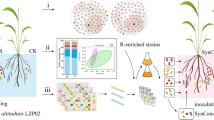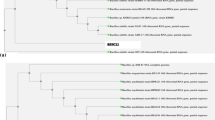Abstract
The development of mixed microbial agents can reduce the use of pesticides and fertilizers in agriculture. However, most previous studies focused only on the overall effects of mixed microbial agents and ignored the interactions between bacteria in mixed systems. In this study, Bacillus subtilis SL-44 and Enterobacter cloacae Rs-2 were used to explore the interactions between two different functional plant growth-promoting rhizobacteria (PGPR). The plant growth-promotion properties and inhibition rate of Rhizoctonia solani were determined, and the mechanism of the interactions under single and co-culture conditions was elucidated via transcriptomics analysis under single and co-culture conditions. Results showed that the co-culture was not conducive to B. subtilis SL-44 growth. Furthermore, the differentially expressed genes related to B. subtilis SL-44 developmental process and cell differentiation were downregulated by 82.7% and 84.8% respectively. Moreover, among the properties, only siderophore production by the mixed culture was higher than that of single cultures because of the upregulation of the siderophore-related genes of B. subtilis SL-44. In addition, results revealed the altruistic relationship between the two strains, and the chemical and non-chemical signals of their interaction. This study provides unique insights into PGPR interactions and offers guidance for the development and application of mixed microbial agents.




Similar content being viewed by others
Data availability
All data generated or analyzed during this study are included in this published article and its supplementary information files.
References
Baldan R, Cigana C, Testa F, Bianconi I, De Simone M, Pellin D, Di Serio C, Bragonzi A, Cirillo DM (2014) Adaptation of Pseudomonas aeruginosa in cystic fibrosis airways influences virulence of Staphylococcus aureus in vitro and murine models of co-infection. PLoS One 9:e89614. https://doi.org/10.1371/journal.pone.0089614
Benomar S, Ranava D, Cardenas ML, Trably E, Rafrafi Y, Ducret A, Hamelin J, Lojou E, Steyer JP, Giudici-Orticoni MT (2015) Nutritional stress induces exchange of cell material and energetic coupling between bacterial species. Nat Commun 6:6283. https://doi.org/10.1038/ncomms7283
Chignell JF, Park S, Lacerda CMR, Long SKD, Reardon KF (2017) Label-free proteomics of a defined, binary co-culture reveals diversity of competitive responses between members of a model soil microbial system. Microb Ecol 75:1–19. https://doi.org/10.1007/s00248-017-1072-1
Combes-Meynet E, Pothier JF, Moenne-Loccoz Y, Prigent-Combaret C (2011) The Pseudomonas secondary metabolite 2,4-diacetylphloroglucinol is a signal inducing rhizoplane expression of Azospirillum genes involved in plant-growth promotion. Mol Plant Microbe Interact 24:271–284. https://doi.org/10.1094/mpmi-07-10-0148
Crouch SR, Malmstadt HV (1967) A mechanistic investigation of molybdenum blue method for determination of phosphate. Anal Chem 39:1084–1089
Diniz JA, Coulthurst SJ (2015) Intraspecies competition in serratia marcescens is mediated by type VI-secreted Rhs effectors and a conserved effector-associated accessory protein. J Bacteriol 197:2350–2360. https://doi.org/10.1128/jb.00199-15
Du J, Zhou J, Xue J, Song H, Yuan Y (2012) Metabolomic profiling elucidates community dynamics of the Ketogulonicigenium vulgare–Bacillus megaterium consortium. Metabolomics 8:960–973. https://doi.org/10.1007/s11306-011-0392-2
Etalo DW, Jeon JS, Raaijmakers JM (2018) Modulation of plant chemistry by beneficial root microbiota. Nat Prod Rep 35:398–409. https://doi.org/10.1039/c7np00057j
Gao CH, Zhang M, Wu Y, Huang Q, Cai P (2019) Divergent influence to a pathogen invader by resident bacteria with different social interactions. Microb Ecol 77:76–86. https://doi.org/10.1007/s00248-018-1207-z
Glickmann E, Dessaux Y (1995) A critical examination of the specificity of the salkowski reagent for indolic compounds produced by phytopathogenic bacteria. Appl Environ Microbiol 61:793–796. https://doi.org/10.0000/PMID16534942
Gunsalus RP, Yanofsky C (1980) Nucleotide sequence and expression of Escherichia coli trpR, the structural gene for the trp aporepressor. Proc Natl Acad Sci U S A 77:7117–7121. https://doi.org/10.1073/pnas.77.12.7117
Hanna EK, Ronen H, Shahar A (2005) MazEF: a chromosomal toxin-antitoxin module that triggers programmed cell death in bacteria. J Cell Sci 118:4327–4332. https://doi.org/10.1242/jcs.02619
Harrison F, Paul J, Massey RC, Buckling A (2008) Interspecific competition and siderophore-mediated cooperation in Pseudomonas aeruginosa. ISME J 2:49–55. https://doi.org/10.1038/ismej.2007.96
Huang Y, Wu Z, He Y, Ye BC, Li C (2017) Rhizospheric Bacillus subtilis exhibits biocontrol effect against Rhizoctonia solani in Pepper (Capsicum annuum). Biomed Res Int 2017:9397619. https://doi.org/10.1155/2017/9397619
Ian DEAL, Andrew RJM, David JS, Gary DB, Alexandra MEJ, Jonathan DM, Andrew G, John PH, Elizabeth MHW (2016) Comparative genomic, proteomic and exoproteomic analyses of three Pseudomonas strains reveals novel insights into the phosphorus scavenging capabilities of soil bacteria. Environ Microbiol l18:3535–3549. https://doi.org/10.1111/1462-2920.13390
Jiahui S, Shuqing L, Nan Z, Xiaoshuang C, Xuan Z, Guishan Z, Qirong S, Ruifu Z (2015) Analysis and cloning of the synthetic pathway of the phytohormone indole-3-acetic acid in the plant-beneficial Bacillus amyloliquefaciens SQR9. Microb Cell Factories 14:130. https://doi.org/10.1186/s12934-015-0323-4
Jin-Hyung L, Yong-Guy K, Giyeon G, Thomas KW, Jintae L (2016) Halogenated indoles eradicate bacterial persister cells and biofilms. AMB Express 6:123. https://doi.org/10.1186/s13568-016-0297-6
Koskiniemi S, Lamoureux JG, Nikolakakis KC, Roodenbeke CK, Kaplan MD, Low DA, Hayes CS (2013) Rhs proteins from diverse bacteria mediate intercellular competition. Proc Natl Acad Sci U S A 110:7032–7037. https://doi.org/10.1073/pnas.1300627110
Leroi F, Pidoux M (2008) Detection of interactions between yeasts and lactic acid bacteria isolated from sugary kefir grains. J Appl Microbiol 74:48–53. https://doi.org/10.1111/j.1365-2672.1993.tb02995.x
Llamas MA, Allsopp LP, Bernal P, Filloux A (2017) The Pseudomonas putida T6SS is a plant warden against phytopathogens. ISME J 11:972–987. https://doi.org/10.1038/ismej.2016.169
Machuca A, Milagres AMF (2003) Use of CAS-agar plate modified to study the effect of different variables on the siderophore production by Aspergillus. Lett Appl Microbiol 36:177–181. https://doi.org/10.1046/j.1472-765X.2003.01290.x
Majerczyk CD, Brittnacher MJ, Jacobs MA, Armour CD, Radey MC, Bunt R, Hayden HS, Bydalek R, Greenberg EP (2014) Cross-species comparison of the Burkholderia pseudomallei, Burkholderia thailandensis, and Burkholderia mallei quorum-sensing regulons. J Bacteriol 196:3862–3871. https://doi.org/10.1128/JB.01974-14
Matsukawa E, Nakagawa Y, Iimura Y, Hayakawa M (2007) Stimulatory effect of indole-3-acetic acid on aerial mycelium formation and antibiotic production in Streptomyces spp. Actinomycetologica 21:32–39. https://doi.org/10.3209/saj.SAJ210105
Mauch F, Mauch-Mani B, Boller T (1988) Antifungal hydrolases in pea tissue : II. inhibition of fungal growth by combinations of chitinase and beta-1,3-glucanase. Plant Physiol 88:936–942. https://doi.org/10.1104/pp.88.3.936
Molina-Santiago C, Pearson JR, Navarro Y, Victoria Berlanga-Clavero M, Caraballo-Rodriguez AM, Petras D, Luisa Garcia-Martin M, Lamon G, Haberstein B, Cazorla FM, de Vicente A, Loquet A, Dorrestein PC, Romero D (2019) The extracellular matrix protects Bacillus subtilis colonies from Pseudomonas invasion and modulates plant co-colonization. Nat Commun 10:1919. https://doi.org/10.1038/s41467-019-09944-x
Murdoch SL, Trunk K, English G, Fritsch MJ, Pourkarimi E, Coulthurst SJ (2011) The opportunistic pathogen Serratia marcescens utilizes type VI secretion to target bacterial competitors. J Bacteriol 193:6057–6069. https://doi.org/10.1128/JB.05671-11
Niu B, Paulson JN, Zheng X, Kolter R (2017) Simplified and representative bacterial community of maize roots. Proc Natl Acad Sci U S A 114:E2450–E2459. https://doi.org/10.1073/pnas.1616148114
Noh SW, Seo R, Park JK, Manir MM, Park K, Sang MK, Moon SS, Jung HW (2017) Cyclic dipeptides from Bacillus vallismortis BS07 require key components of plant immunity to induce disease resistance in Arabidopsis against Pseudomonas infection. Plant Pathol J 33:402–409. https://doi.org/10.5423/ppj.Oa.11.2016.0255
Oh DC, Jensen PR, Kauffman CA, Fenical W (2005) Libertellenones A-D: induction of cytotoxic diterpenoid biosynthesis by marine microbial competition. Bioorg Med Chem 13:5267–5273. https://doi.org/10.1016/j.bmc.2005.05.068
Olaf T, Victor CL, Marlies van den B, Saskia G, Thierry KSJ, Niels Z, Marco K, Ales S, Hans Z, Cornelis H, Harrie B, Wietse de B, Paolina G (2017) Exploring bacterial interspecific interactions for discovery of novel antimicrobial compounds. Microb Biotechnol 10:910–925. https://doi.org/10.1016/j.tim.2016.12.002
Paramaporn R, Pimonsri MA, Kanitta S, Varaporn V, Natta T (2020) Indole signaling decreases biofilm formation and related virulence of Listeria monocytogenes. FEMS Microbiol Lett 367:fnaa116. https://doi.org/10.1093/femsle/fnaa116
Pukatzki S, Ma AT, Sturtevant D, Krastins B, Sarracino D, Nelson WC, Heidelberg JF, Mekalanos JJ (2006) Identification of a conserved bacterial protein secretion system in Vibrio cholerae using the Dictyostelium host model system. Proc Natl Acad Sci U S A 103:1528–1533. https://doi.org/10.1073/pnas.0510322103
Roberto D, Anna A, Michael D, Adrian C, Luca T, Paolo P, Carmen B (2018) Improved drought stress response in alfalfa plants nodulated by an IAA over-producing Rhizobium strain. Front Microbiol 8:2466. https://doi.org/10.3389/fmicb.2017.02466
Santos MNM, Cho ST, Wu CF, Chang CJ, Kuo CH, Lai EM (2020) Redundancy and specificity of type VI secretion vgrG Loci in antibacterial activity of Agrobacterium Tumefaciens 1D1609 strain. Front Microbiol 10:3004. https://doi.org/10.3389/fmicb.2019.03004
Sela-Buurlage MB, Ponstein AS, Bres-Vloemans SA, Melchers LS, Elzen PJM v, Cornelissen BJC (1993) Only specific tobacco (Nicotiana tabacum) chitinases and β-1,3-glucanases exhibit antifungal activity. Plant Physiol 101:857–863. https://doi.org/10.2307/4275045
Singh RP, Runthala A, Khan S, Jha PN (2017) Quantitative proteomics analysis reveals the tolerance of wheat to salt stress in response to Enterobacter cloacae SBP-8. PLoS One 12:e0183513. https://doi.org/10.1371/journal.pone.0183513
Sunhee L, Flores-Encarnación M, Contreras-Zentella M, Garcia-Flores L, Escamilla JE, Christina K (2004) Indole-3-acetic acid biosynthesis is deficient in Gluconacetobacter diazotrophicus strains with mutations in cytochrome c biogenesis genes. J Bacteriol 186:5384–5391. https://doi.org/10.1128/jb.186.16.5384-5391.2004
Szczech M, Shoda M (2006) The effect of mode of application of Bacillus subtilis RB14-C on its efficacy as a biocontrol agent against Rhizoctonia solani. J Phytopathol 154:370–377. https://doi.org/10.1111/j.1439-0434.2006.01107.x
Tanouchi Y, Pai A, Buchler NE, You L (2012) Programming stress-induced altruistic death in engineered bacteria. Mol Syst Biol 8:626. https://doi.org/10.1038/msb.2012.57
Traxler MF, Seyedsayamdost MR, Clardy J, Kolter R (2012) Interspecies modulation of bacterial development through iron competition and siderophore piracy. Mol Microbiol 86:628–644. https://doi.org/10.1111/mmi.12008
Tytova LV, Brovko IS, Kizilova AK (2013) Effect of complex microbial inoculants on the number and diversity of rhizospheric microorganisms and the yield of soybean. Int J Microb Res 4:267–274
Vacheron J, Desbrosses G, Renoud S, Padilla R, Walker V, Muller D, Prigent-Combaret C (2018) Differential contribution of plant-beneficial functions from Pseudomonas kilonensis F113 to root system architecture alterations in Arabidopsis thaliana and Zea mays. Mol Plant Microbe Interact 31:212–223. https://doi.org/10.1094/mpmi-07-17-0185-r
Verhaegh SJC, Flores AR, van Belkum A, Musser JM, Hays JP (2013) Differential virulence gene expression of group a Streptococcus Serotype M3 in response to co-culture with Moraxella catarrhalis. PLoS One 8:e62549. https://doi.org/10.1371/journal.pone.0062549
Wang W, Wu Z, He Y, Huang Y, Li X, Ye BC (2018) Plant growth promotion and alleviation of salinity stress in Capsicum annuum L. by Bacillus isolated from saline soil in Xinjiang. Ecotoxicol Environ Saf 164:520–529. https://doi.org/10.1371/journal.pone.0062549
West SA, Diggle SP, Buckling A, Gardner A, Griffins AS (2007) The social lives of microbes. Annu Rev Ecol Evol Syst 38:53–77. https://doi.org/10.1146/annurev.ecolsys.38.091206.095740
Wu Z, Yue H, Lu J, Li C (2012) Characterization of rhizobacterial strain Rs-2 with ACC deaminase activity and its performance in promoting cotton growth under salinity stress. World J Microbiol Biotechnol 28:2383–2393. https://doi.org/10.1007/s11274-012-1047-9
Wu Z, Huang Y, Li Y, Dong J, Liu X, Li C (2019) Biocontrol of Rhizoctonia solani via induction of the defense mechanism and antimicrobial compounds produced by Bacillus subtilis SL-44 on pepper (Capsicum annuum L.). Front Microbiol 10:2676. https://doi.org/10.3389/fmicb.2019.02676
Funding
This research was supported by the National Natural Science Foundation of China (U1803332, 32060026), Key Research and Development Program of Shaanxi Province (2020NY-132, 2021NY-141), the Scientific Research Plan for Local Special Service of Shaanxi Provincial Education Department (20JC014).
Author information
Authors and Affiliations
Contributions
Professor ZS Wu was conceived and supervised the study as corresponding author; Y Li designed and performed this experiments, and she wrote the manuscript; YH He and WF Wang gave suggestions during the experiment and revised the manuscript; XP Li assisted for performing experiments; XL Xu assisted on solving experimental problems in the study; XC Liu and Professor C Li revised the important academic content of the article. All authors approved the final article.
Corresponding author
Ethics declarations
Ethics approval
Not applicable.
Consent to participate
Yes.
Consent for publication
Yes.
Competing interests
The authors declare no competing interests.
Additional information
Responsible Editor: Diane Purchase
Publisher’s note
Springer Nature remains neutral with regard to jurisdictional claims in published maps and institutional affiliations.
Rights and permissions
About this article
Cite this article
Li, Y., He, Y., Wang, W. et al. Plant-beneficial functions and interactions of Bacillus subtilis SL-44 and Enterobacter cloacae Rs-2 in co-culture by transcriptomics analysis. Environ Sci Pollut Res 28, 56333–56344 (2021). https://doi.org/10.1007/s11356-021-14578-y
Received:
Accepted:
Published:
Issue Date:
DOI: https://doi.org/10.1007/s11356-021-14578-y




